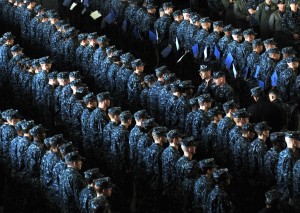
Navy Grows as Air Force and Army Fight off Personnel Cuts
The Navy will increase its ranks over the next five years while the Army, Air Force and Marine Corps shrink.
At the same time, recent world events have changed the equation for Army and Air Force leaders weighing their own end-strength calculations, leading them to slow down or reverse planned force cuts.
Navy leaders are now planning the composition and make-up of the fleet of sailors anticipated in 2025 as the service prepares to slightly increase its end strength over the next five years, service officials said.
Since the Navy has refined what it wants the service’s fleet of ships to look like by 2025, Navy leaders are beginning to sharpen their focus on the number of sailors expected to man the fleet. The current Navy plans call for a slight increase from its current number of 325,000 sailors to roughly 328,000 by the end of the next five years.
“We kind of have a sense of what the fleet looks like, now we can have conversations about what the sailors of 2025 will look like. It is a matter of attracting and keeping the sailors to man that fleet,” said said Cmdr. Chris Servello, spokesman for the Chief of Navy Personnel.
Many observers have wondered about Navy end strength in light of how global instability and recent flashpoints in Iraq and Russia appear to be shaping Air Force and Army force size considerations. The ongoing conflict against the Islamic State in Iraq and Syria (ISIS) as well as Russian military activity and fighting in Ukraine have influenced the Army and Air Force to re-think, change or slow down planned cuts to the size of their forces.
Just last month, Air Force Secretary Deborah James announced that the service would halt its plan for a new round of lay-offs in 2015.
“We have reduced far enough. We will not go lower. We will fight to hold on to the numbers that we now have,” James said last month.
The Air Force has about 315,000 officers and enlisted members on active duty, according to Pentagon personnel statistics dated Oct. 31. That’s the lowest level since the service was created in 1947.
Meanwhile, Army Chief of Staff Gen. Raymond Odierno recently said previous planned reductions in Army end strength may no longer make sense in light of emerging global threats such as ISIS. Previous plans to reduce the Army’s end strength to 490,000 are now being revisited, Army officials said. The Army’s current active duty force is roughly 520,000 soldiers.
Congress and the military’s budget will have a say over how big these service leaders can maintain their forces. Lawmakers have blocked efforts by the military to cut down their personnel costs by maintaining pay raises and benefits that service leaders have sought to cut.
Sequestration will also dictate the future end strength sizes for each force. The mandatory cuts instituted by the Budget Control Act will slash the military’s budget unless Congress can again roll back the cuts to the Defense Department as it did this past year. Sequestration cuts are slated to resume in 2016.
The Navy’s end-strength increase is at least partially funded in the recently passed 2015 defense bill which includes roughly $45 billion for personnel costs.
Navy officials said the stability of planned force-size increases will enable them to focus on recruiting and retention. At the same time, Navy officials also say the service is glad to be growing at a time when naval presence is needed around the globe.
Navy leadership has asked the Chief of Naval Personnel to look into manning the fleet of 2025 with a mind to maintaining a global naval presence for decades to come.
Servello said the Navy’s future fleet of sailors will be critical to ensuring the service can respond as needed to potential global flare-ups.
“We think the stability and the numbers we have gives us the ability to carry out the traditional presence mission that people think of when they think of the Navy,” he said. “Now it’s time to focus on modernization from a people standpoint. How do we remain competitive when it comes to bringing talented folks in and keeping them?”
As part of this effort, the Navy is looking at a variety of ways to expand career options for sailors. These include options such as new educational opportunities, providing ways for sailors to take time off and re-enter service, and vary their sea schedule, among other things.
“The recruit that walks in the door is expecting the workplace to match his or her skills. We need to make sure we can accommodate the skills and talents that come through the door so we can keep them,” Servello explained.
Source: Military.com




